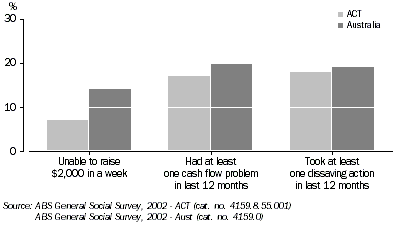Contents >>
Financial Stress in the ACT (re-issue) - May 2005
The 2002 ABS General Social Survey (GSS) provides many insights into the economic wellbeing of various groups in the Australian community. In particular, the GSS collected information on aspects of "financial stress" in the Australian community.
Financial stress is a multi-dimensional concept and so there are various ways in which it might be measured. This article focuses on three broad measures collected in the GSS. The analysis that follows considers how patterns of financial stress in 2002 differed between the ACT and Australia as a whole. It also investigates how financial stress varies according to people's personal and household characteristics.
We focus on three broad aspects:
1. Ability to raise $2,000 within a week for something important, which considers whether people thought they or other members of their household could obtain $2,000 for something important, within a week.
2. Dissaving - which considers whether, over the past 12 months, households had used assets, or increased or incurred debts to pay for basic living expenses (examples include reducing home loan repayments, spending savings, increasing the balance on credit cards by $1,000 or more, borrowing money, or selling household goods or jewellery).
3. Cash flow problems - which considers whether households were so short of money they were:
- unable to pay for basic utilities, their mortgage or rent, car registration or insurance
- unable to heat their home, or make the minimum payment on their credit card
- went without meals, pawned or sold something for cash, or sought assistance from friends, family or welfare organisations.
FINANCIAL STRESS IN THE ACT AND AUSTRALIA
In the ACT in 2002:
- 7% of people aged 18 and over could not raise $2000 in a week, compared with 14% of all Australians;
- 17% had a cash flow problem within the previous 12 months, compared with 20% of all Australians; and
- 18% had taken at least one dissaving action in the previous 12 months, compared with 19% of all Australians.
Overall, the indicators show those living in the ACT are less likely to suffer financial stress than Australians on average.
Selected Financial Stress Indicators

HOUSEHOLD CHARACTERISTICS AND FAMILY STRESS
The 2002 GSS presents financial stress information for people aged 18 and over (who we describe as adults from now on) living in households, broken down by four household characteristics: family type, age, employment and household tenure.
Family type
Financial stress in the ACT varied with family type. For instance 36% of single parents (adults in one parent families with dependent children) had at least one cash flow problem in the 12 months before the survey, compared to only 8% of adults living in couple only, one family households.
This pattern is similar to that for Australia as a whole, although as the graph below shows, single parents in the ACT reported financial stress less often than their counterparts across the whole country.
Selected Financial Stress Indicators, by one parent family households

Age
The incidence of financial stress tended to decrease with age in the ACT (broadly consistent with what happened for Australia as a whole), although more 25-34 year olds reported dissaving actions than those aged 18-24.
Selected Financial Stress Indicators, by age of selected person in household

 Print Page
Print Page